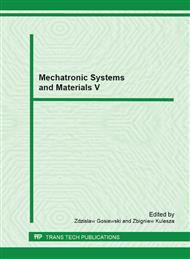[1]
J. German, Podstawy mechaniki kompozytów włóknistych, Wydawnictwo Politechniki Krakowskiej, Kraków 2001 (in Polish).
Google Scholar
[2]
S. Zolkiewski, Glue joints of laminates, Research results for samples connected by means of the adhesive layer in: A. Buchacz, A. Baier, J. Świder (Eds. ), Experimental Tests of Chosen Fibre-Metal Laminates, Silesian Univeristy of Technology Press, Gliwice 2012, p.21.
Google Scholar
[3]
H. Leda, Kompozyty polimerowe z włóknami ciągłymi, Wydawnictwo Politechniki Poznańskiej, Poznań 2000 (in Polish).
Google Scholar
[4]
A. Buchacz and M. Płaczek, Development of Mathematical Model of a Mechatronic System, Solid State Phenomena 164 (2010) 319-322.
DOI: 10.4028/www.scientific.net/ssp.164.319
Google Scholar
[5]
A. Buchacz and M. Płaczek, Selection of Parameters of External Electric Circuit for Control of Dynamic Flexibility of a Mechatronic System, Solid State Phenomena 164 (2010) 323-326.
DOI: 10.4028/www.scientific.net/ssp.164.323
Google Scholar
[6]
A. Dobrzańska-Danikiewicz, Foresight methods for technology validation, roadmapping and development in the surface engineering area, Archives of Materials Science Engineering 44, 2 (2010) 69-86.
Google Scholar
[7]
C. Grabowik and K Kalinowski, Object-Oriented Models in an Integration of CAD/CAPP/CAP Systems. Hybrid Artificial Intelligent Systems, Part II Book Series: Lecture Notes in Artificial Intelligence, 6679, 405-412 (2011).
DOI: 10.1007/978-3-642-21222-2_49
Google Scholar
[8]
A. Baier and M. Majzner, Application of feature method to the modeling of composite structural elements, Journal of Achievements in Materials and Manufacturing Engineering 45, 1 (2011) 30-38.
Google Scholar
[9]
A. Baier and M. Majzner, Analysis of composite structural elements, Journal of Achievements in Materials and Manufacturing Engineering 43, 2 (2010) 577-585.
Google Scholar
[10]
S. Zolkiewski, Attenuation-frequency Characteristics of Beam Systems in Spatial Motion, Solid State Phenomena 164 (2010) 349-354.
DOI: 10.4028/www.scientific.net/ssp.164.349
Google Scholar
[11]
S. Zolkiewski, Numerical Application for Dynamical Analysis of Rod and Beam Systems in Transportation, Solid State Phenomena 164 (2010) 343-348.
DOI: 10.4028/www.scientific.net/ssp.164.343
Google Scholar
[12]
S. Zolkiewski, Dynamical Flexibility of Complex Damped Systems Vibrating Transversally in Transportation, Solid State Phenomena 164 (2010) 339-342.
DOI: 10.4028/www.scientific.net/ssp.164.339
Google Scholar
[13]
A. Dobrzańska-Danikiewicz, Foresight of material surface engineering as a tool building a knowledge-based economy, Materials Science Forum 706-709 (2012) 2511-2516.
DOI: 10.4028/www.scientific.net/msf.706-709.2511
Google Scholar
[14]
B. Surowska, Functional and hybrid materials in air transport, Eksploatacja i Niezawodnosc – Maintenance and Reliability 3 (2008) 30-40.
Google Scholar
[15]
S. Zolkiewski, Testing composite materials connected in bolt joints, Journal of Vibroengineering 13, 4 (2011) 817-822.
Google Scholar


